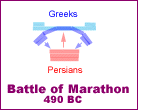![]()
The Greatest Success of the Phalanx
Warfare in Greece and Rome
The legion's strict formation was one aspect of its novelty; the other wasBy combining the missile and shock weapons with the formation of the legion, the Romans created a self-contained fighting unit
the inventive arming of the Roman soldiers, called legionnaires.A legionnaire carried a heavy, short-range javelin called a pilum, which
was thrown or thrust and which could penetrate all enemy armor of the
time. He also employed a broad, heavy 20-inch sword known as a
gladius and was protected by a shield, helmet and body armor.In battle, the use of these arms was closely related to the unit's
formation: the first of a maniple's three rows would attack the enemy by
hurling javelins; then both the first and second rows would charge with
their swords.
![]()
The Greatest Success of the Phalanx
At the Battle of Marathon (490 BC), Greek troops defending their homeland
defeated a Persian army
of vastly superior numbers. When Persian soldiers advanced towards his
own lines, a Greek general
named Militiades of Athens ordered the wings of his infantry to hold their
ground--while instructing the
hard-pressed center to yield. Having created a semicircle around the Persian
infantry, Militiades
ordered his wings to converge on the flanks and rear of the Persian forces--who
were demoralized and
expelled from the Greek homeland.
 |
Illustration of the Battle of Marathon (490 BC). The Greek lines formed
a semicircle around the advancing Persian forces.
Then, the heavily reinforced Greek flanks sandwiched the Persian lines
between them.
![]()
A Slanted Line of Men
In an ancient battle between two Greek city-states, a tactician named Epaminondas
developed a new mode
of attack--known as the "oblique," or slanted line. By employing his superior
cavalry and by heavily
reinforcing the left wing of his infantry, he punctured his enemy's right
flank, which recoiled in disorder and
deteriorated into a confused mob.
 |
Illustration of the Oblique. The heavily reinforced left wing of Epaminondas
penetrated the enemy's right
flank, which fell back in confusion.
The oblique order was further developed by two barbarian princes: Phillip II and Alexander the Great.
PHILIP II incorporated well-trained light cavalry
as "hinges" for his infantry; this advance cured two major handicaps of
the phalanx: the vulnerability of its flanks
and its inability to maneuver on rough ground.
ALEXANDER, Philip's son, defeated a force five
times the size of his own by rapidly advancing the heavy cavalry and
infantry of his right wing and penetrating
the phalanx of his Persian enemy.
![]()
The Roman Legion
Tightly-organized and well-trained, the Roman legion had a simplicity that only concealed its innovation and true power.
A legion was made up of ten 360-man units called "cohorts," which in turn
were
made up of three 120-man units called "maniples." Each maniple was broken
into
three lines, which were staggered in a checkerboard arrangement to maximize
mobility and flexibility. Heavy infantry comprised the first two lines;
the third was
composed of alternating cavalry, light infantry and reserves of heavy troops.
 |
Illustration of the Roman Legion's Formation. The basic battle formation
of the Roman legion was made up of three lines.
The first two were heavy infantry; the third a mixture of cavalry and
light and heavy infantry.
Roman generals conducted massive frontal assaults that relied on the
power, training and numbers of their legions. In Hannibal,
they faced a general who capitalized on his cavalry--wiping out inferior
Roman horsemen and encircling the enemy legions from
behind.
 |
 |
 |